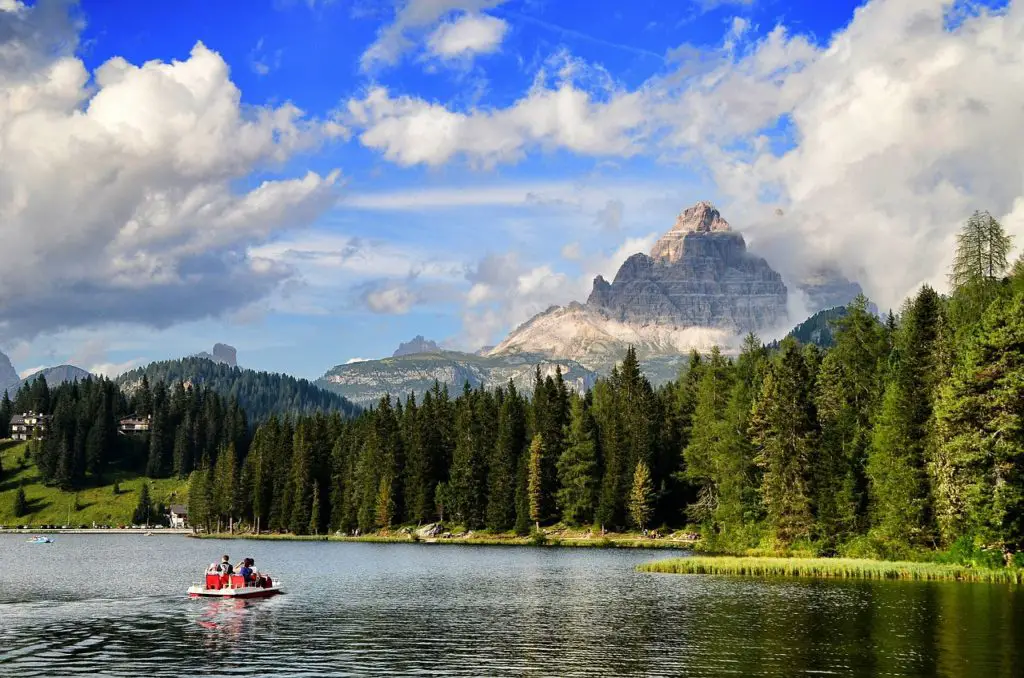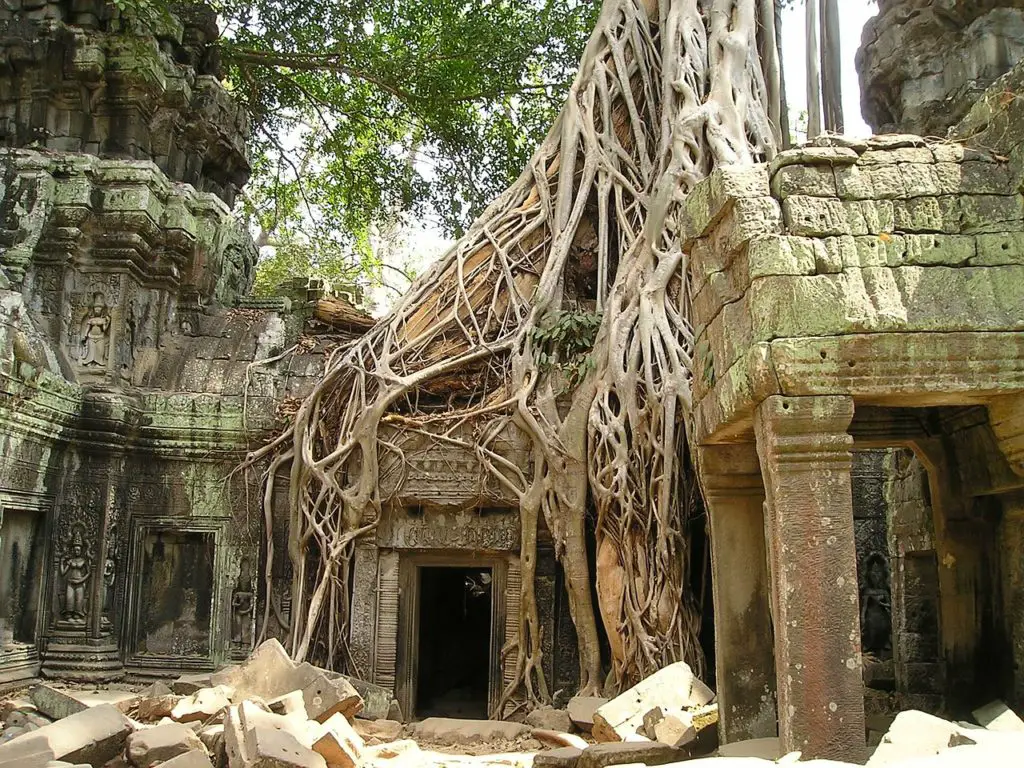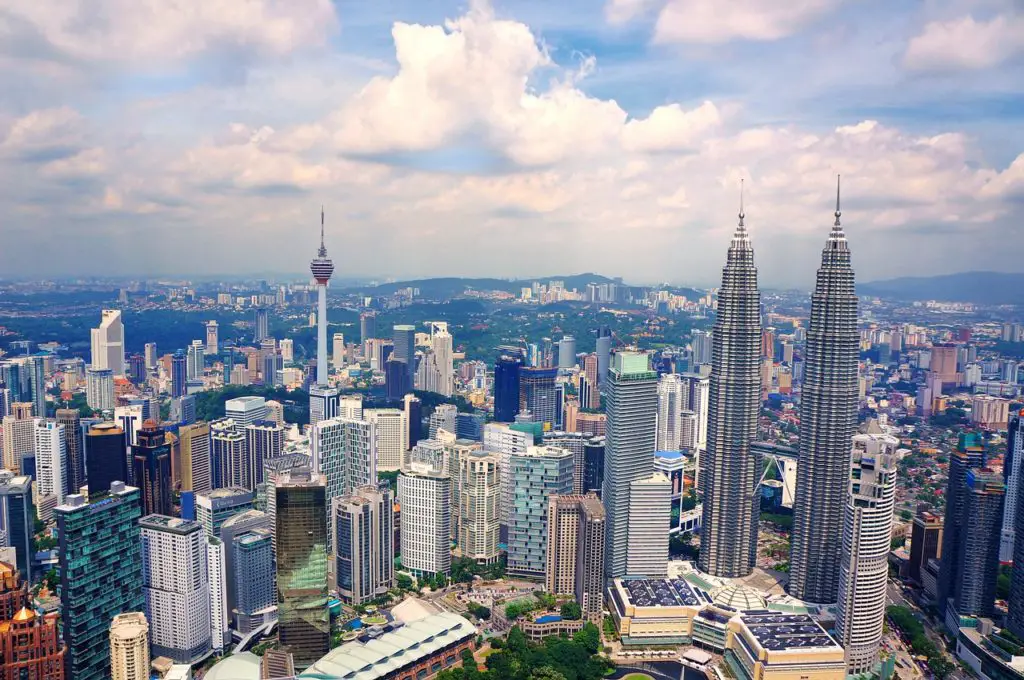The Dolomites or “Pale Mountains” are in northeastern Italy. Whether it’s emerald green or ice-cold glacial lakes, several stunning lakes in the Dolomites are perfect for those postcard-like photos.
In this post, we check out the 7 stunning lakes in the Dolomites, the city closest to the Dolomites, where to go for the best views, and when is the best time to visit the Dolomites. You will find all the answers to these questions in this post.
- Where are the Dolomites Mountains?
- What are the 7 stunning lakes in the Dolomites?
- When should I visit the Dolomites?
- What is the highest mountain on the Dolomites?
- Where is the best view of the Dolomites?
- Are the Dolomites worth visiting?
Disclaimer: This post contains affiliate links. This means, if you click on the link and purchase the item, I will earn a small commission at no extra cost to you. Please read my Disclaimer Policy for more information.
Where are the Dolomites Mountains?
The Dolomites or Alpi Dolomitiche are a group of mountain ranges in northeast Italy. The Dolomites shares borders with the Isarco Valley, the Pusteria, and the Adige Valley.
This mountain range has 18 impressive peaks all of which are more than 10,000 feet. The Dolomiti Bellunesi National Park became a UNESCO World Heritage Site in 2009.
During the spring months of April till June, flowers such as rhododendrons, edelweiss, and bellflowers dominate the valley.
Summer begins in May and lasts until mid-September. This is the best time for hiking, trekking, or zip-lining across the longest zip line in the Dolomites. Check out the 7 Ways To Relax and Recharge In The Heart of Dolomites and Summer In The Dolomites to know more.
If skiing, ice-skating, sledding, and snowshoeing are on your Dolomite bucket list, then winter is the best time to go. Winter begins in December and lasts till March, sometimes early April. Check out the 10 Winter Wonderland Photos From The Italian Dolomites to know more.
How do you get to the Dolomites?
There are three ways to get to the Dolomites: either by car, bus, or train. The park is in Veneto which is in the Province of Belluno. This province is approximately 62 miles from Venice. The two major entrances to the park are Belluno and Feltre.
Car
Belluno
If coming to Belluno from Venice, take the A27 motorway and exit Belluno. Get onto State Road 51 until you reach the Ponte Nelle Alpi roundabout. Here, get onto State Road 50 and take the turn towards Viale Dolomiti until you reach the town of Belluno.
If coming from Padua, continue on the A4 Milan to Venice motorway until you reach Mestre Tollbooth. From there, take the A27 motorway towards Belluno.
Feltre
From Vicenza, take the A31 Val d’Astico Motorway and exit at Dueville. And then, continue towards SS 47 in the Suguna Valley to Primolano and then head towards State Road 50 to get to Belluno.
Friuli Venezia Guilia
If you are coming from Gorizia, Trieste, and the Slovenian border, take the A4 motorway and then the A27 motorway towards Belluno.
If you are coming from Udine and Pordenone, follow State Road 13 to Vittorio Veneto and then get onto State Road 51 to Ponte Nelle Alpi. After that, get onto State Road 50 to Belluno. The main entrance to the park is at Provincial Road 2 of Mis Valley.
Bus
The Dolomiti Bus services serve the 61 municipalities in the province of Belluno. This bus line also manages the urban bus services in Feltre, Pieve di Cadore, and Auronzo. To know more about this bus service, click here.
Train
The Padua-Montebelluna-Feltre-Belluno-Calalzo railway lines serve the towns of Feltre and Belluno. There are direct trains from Venice to Belluno and these take about 2 hours with a distance of 100 miles and costs about €8.75 ($10) per person.
Book your tickets or explore the schedules to Belluno at Trenitalia.
How did the Dolomites become the “Pale Mountains”?
The name Pale Mountains came about after the discovery of dolomite by Déodat Gratet de Dolomieu who first described the mineral. The Dolomites, the mineral, have the appearance of limestone and do not show any acid reactions.
The Dolomites are fossilized coral reefs that were formed during the Triassic Period approximately 250 million years ago.
Do you know that the Dolomites were once the seabed of the ancient Tethys Ocean?
The collision of the African and European tectonic plates formed this mountain range. The collision caused the seabed to rise and Tethys Ocean disappeared. Once the ocean disappeared, the Dolomites were born.
Pale Mountains describe the whitish-grey sedimentary rocks found in these ranges. Check out The Birth of The Dolomites and How Were The Dolomites Formed to know more.
The Ladin Legends of the Dolomites
The legends surrounding the Dolomites were oral renditions passed down through the generation and associated with the Ladins. The Ladins are an ethnic group whose native language is Ladin.
Although a minority in Italy, their national epic, The Kingdom of the Fanes is somewhat based on historical events which take place on the Fanes Plateau, Lake Braies, and the Falzarego Pass.
Legend of the Alpine Glow
The story is of King Laurin and his roses. According to local belief, on the Catinaccio mountains lived a cunning king of the dwarves, King Laurin. He owned a magic belt which gave him the power of invisibility.
One day, King Adige held a great feast and did not invite King Laurin who went anyway. While invisible, he fell in love with Similde who was King Adige’s daughter. He kidnapped her and cast a spell to cover the mountain in a beautiful layer of red roses.
However, King Laurin was soon discovered despite his invisibility, as the trampled roses left a path which the soldiers of King Adige followed. The king of dwarves was caught and his magic belt removed.
He then placed a curse on the rose gardens by saying, “no human would be able to admire you, neither during the day nor at night”. That is why during sunrise and sunset, which is neither day nor night, the mountain range turns a beautiful pink and orange hues hue.
Legend of the Pale Mountains
The story goes that a prince on the Dolomite dreamed of reaching the moon. One day, he succeeded and reached the moon where he fell in love at first sight with a beautiful moon princess.
The prince and his new princess eventually returned to the Dolomites. On of her walk in the woods, the moon princess met the king of the dwarves who assured the princess that he would bring back her smile provided that the dwarf king and his subjects be allowed to live on the mountains.
The following days saw the princess becoming sadder and paler. However, all that changed when the night of the full moon arrived. In an instant, a flicker of bright wires spread across the slopes.
The princess began to smile at the beautiful sight. The dwarves were continuously spinning the moonlight which created a silvery blanket that covered the Dolomites.
Read Legends of The Italian Dolomites and The Most Beautiful Legends of the Dolomites to know more.
What are the 7 stunning lakes in the Dolomites?
The seven stunning lakes in the Dolomites are described below. We begin with Lago di Braies and end with Lago Delle Baste.
Lago di Braies
The first in our stunning lakes in the Dolomites is Lago di Braies (Italian) or Pragser Wildsee (German) is located within the Prags Dolomites in the South Tyrol, Italy.
Lake Braies is one of the most beautiful lakes in Italy. With bluish-green waters, it is no wonder that it is one of The 10 Italian Lakes To See At Least Once In A Lifetime. The gorgeous views of and from this lake led to its nickname as the “Pearl of the Dolomite”.
This lake is one of the most photographed lakes in the world. And, the best viewpoints are not necessarily the common tourist viewpoints. Take an Easy and Spectacular Lake Braies Walking Tour, you will not regret this easy walk around the lake which can be completed within an hour.
Legend of Lago di Braies
According to local legend, the gate to the underworld kingdom of Fanes is located at the lake’s southern end. The local Ladin name Croda del Becco is “Sass dla Porta” which means “Gate Mountains”.
Check out The Legend And Myth Of The Scenic Italian Dolomites to know more of these legends.
Lago di Dobbiaco
The second in our stunning lakes in the Dolomites is Lago di Dobbiaco or Toblacher See, situated in Val di Landro, which links Dobbiaco with Cortina. The majestic Three Peaks View is about 4.3 miles from Dobbiaco is a must-visit when here.
Some of the things you can do here are to explore the Top 8 Hikes Around Toblacher Lake or you can hike up to the open-air museum and war cemetery were the trenches, posts, and tunnels used during the First World War between Austrians and Italians.
Lake Dobbiaco is known as a bird migration sanctuary during spring and summer and is ideal for birdwatching. There is an easy hike for families with children, the nature trail takes visitors along 11 stations that give an insight into the flora and fauna of the area.
Another fun activity to do here in summer is swimming. This lake is also perfect for swimming, surfing, or stand-up paddleboarding. Check out the Lakes in South Tyrol that are perfect for outdoor enthusiasts.
Fun Winter Tip:
This lake freezes in winter. And, that makes it suitable for skating, curling, and cross-country skiing. Fancy experiencing a horse-drawn carriage over the frozen lake. You can do it here! After all, It is a once-in-a-lifetime experience, isn’t it?
Lago di Misurina
The third in our stunning lakes in the Dolomites is Lago di Misurina. This lake is the largest natural lake with a maximum depth of 5 meters.
Lake Misurina was used during the 1956 Winter Olympics in Cortina for speed skating. This was the last time speed skating was held on natural ice. Check out Looking Back: Photos From The First 12 Winter Olympics to know more.
Do you know which nation won the most medals in the speed skating event during the 1956 Winter Olympics?
It was the Soviet Union that won the most medals during the speed skating event. The total medals collected during the race were 7 Gold, 1 Silver, and 2 Bronze.
Lago di Sorapis
The fourth in our stunning lakes in the Dolomites is Lago di Sorapis. The lake is known for its beautiful turquoise to light blue hues. The colors are created by fine rock dust from the glacier above the lake.
The best way to reach this lake is by hiking the panoramic track. The trailhead starts and ends at Passo de Croci and the hike is about 7 miles long with medium difficulty. The trek takes about 4 hours to complete, depending upon individual fitness level.
Check out Walk To The Enchanting Lake Sorapis to know more.
Lago di Carezza
The fifth in our stunning lakes in the Dolomites is Lago di Carezza. This is another small lake that is known for its colors and a fairy tale. The lake is on the western end of the Dolomites, about 12 miles southeast of Bolzano.
Check out the 15 Things To Know When Visiting Lago di Carezza to know more. This lake is also a popular spot for hiking. The 3.5-kilometer hike is relatively easy and can be completed within 2 hours. Check out the Lago di Carezza Hike to know more.
Lago di Tovel
The sixth in our stunning lakes in the Dolomites is Lago di Tovel. This lake is at an elevation of 1178 meters and is located in Trentino, Italy. This lake was formed from a landslide that took place here in 1300. Situated in the Adamello-Brenta National Park, this lake was once famous for turning red during the summer months up until the 1960s.
Legend of the Red Lake
In the past, this area was ruled by the King of Ragoli who had a beautiful princess. One day, a proposal came for the princess from a foreign sovereign. The princess refused the proposal.
The rejection of the foreign sovereign led to a war between the King of Ragoli and the rejected suitor. The battle was at the shores of Lake Carezza. It is believed that the slaughtered subjects turned the lake red.
However, in 2004, scientists attributed the red color of the lake to two species of algae are Tovellia sanguinea and Baldinia anauniensis.
Legend of Ondina
If you visit the lake, you will see a statue of a beautiful nymph. She is Ondina, a water nymph who once lived in the depths of the lake. Legend has it that her magical voice would bewitch wanderers who fell in love with her.
One day, a persistent sorcerer went to a witch who lived in the mountains nearby to seek advice and was told to disguise himself as a merchant trading in jewels and precious stones. With the jewels, the sorcerer and the magician built a rainbow so beautiful that Odina was lured onto the shores of the lake.
In his greed to capture Odina, the sorcerer forgot his disguise and Odina immediately recognized him and disappeared into the lake, never to be seen again. The sorcerer, in his regret, destroyed the rainbow. The jewels and precious stones fell onto the lake and the sorcerer disappeared into the mountains and was never heard again.
This legend gives this lake its nickname, the Rainbow Lake. Don’t be surprised if the color of the water changes from blue to green to gold before your eyes. Now, you know why!
Lago Delle Baste
The last in our stunning lakes in the Dolomites is Lago Delle Baste. This small is at the foot of Mount Mondeval near Forcella Giau. This view from this lake gives you the profile of El Caregòn del Padreterno or “Throne of Gods”.
This lake is an attraction in its own right as the only way to get here is through a medium-difficulty hike beginning at Passo Giau and ends at the lake itself. Along the route, you will pass Lastoi del Formini or “The City of Stones”.
Once you have soaked in the views, head down to the Mesolithic site of the Mondeval Man. The skeletal remains of this Cro-Magnon hunter who lived 7,500 years ago and was buried with his belongings.
However, the perfect preservation of the complete skeletal remains was exceptional in that his last meal gave archaeologists a better understanding of the hunter-gatherers’ way of life. For information about hiking this trail, check it out on a small dream.
What is the highest mountain on the Dolomites?
Marmolada
Marmolada is about 62 miles north-northwest of Venice and is located between Trentino and Veneto. The highest peak is at Punta Penia which is 3,343 meters followed by Punta Rocca at 3,309 meters. These mountain ranges are known as ‘La Regina Delle Dolomiti’ or the Queen of the Dolomites.
The northern slopes have a glacier and the Fedaia Lake that is fed by melting water of the glacier. The glacier can be viewed from all major lookout points. However, if you are into hiking, it’s the south wall that you need to conquer.
In recent years, Italian scientists have warned that the glaciers of Marmolada could disappear within 15 years due to global warming. The glacier has already lost 80% of its volume over the last 70 years as the glacier’s extinction is inevitable.
There are 448 hiking routes with 58 categorized as long-distance hikes while there are 4 pilgrim routes. Check out Hiking in the Marmolada Group for an overview of the best routes.
Where is the best view of the Dolomites?
Other than the stunning lakes in the Dolomites, several places that have the best views of the Dolomites include Tre Cime di Lavaredo, Cortina, Pale di San Martino, Alpe di Siusi, and Val di Funes.
Tre Cime di Lavaredo
The first in our best views of the Dolomites is Tre Cime di Lavaredo which in Italian means The Three Peaks of Lavaredo.
Tre Cime di Lavaredo is one of the best-known mountain groups in the Alps. The three peaks are Cima Piccola (“little peak”), Cima Grande (“big peak”), and Cima Ovest which means “western peak”. Check out Tre Cime di Lavaredo Spectacular Hike in The Dolomites for a descriptive guide on what to expect when hiking Tre Cime di Lavaredo.
Cortina D’Ampezzo
The next in our best views of the Dolomites is Cortina D’Ampezzo. Cortina is a town in the heart of the Dolomites famous for winter sports such as skiing, ice hockey, and cross-country skiing.
What is Cortina Famous For?
Some of the things Cortina is famous for include skiing, hiking, filming locations for movies, Cinque Torri, and the site for the next Winter Olympics.
Cinque Torri
This group of five rock towers is popular during the summer months for rock climbing and hiking. In winter, this area is a popular ski area whose tracks are part of the Dolomiti Superski area. Check out Mountain Project’s Cinque Torri Rock Climbing to know more.
Winter Olympics
Cortina hosted the 1956 Winter Olympics where The Cortina Games were unique in that the venues were walking distance from each other. In 2026, Milano Cortina will once again host the Olympics amidst beautiful settings, combining modern European and classic Alpine communities.
Pale di San Martino
The next in our best views of the Dolomites is at Pale di San Martino which is part of the larger Pala Group massifs. The massifs here are the largest in the Dolomites with a surface area of 240 km². Pale di San Martino is between the towns of Veneto and Trentino.
With peaks, spires, and corners, these peaks are the fossilized tropical coral reefs of the Tethys Sea that once covered this region. With a history that goes back 300 million years ago, these peaks are ancient as they are beautiful.
Legend of Pale di San Martino
The local legend mentions the Mazaròl. He is a small man with a long beard and wears a strawberry-colored hood, black cloak, and pointed shoes. If you are at the foot of Pale di San Martino and you see strange footprints. Do not follow them!
The Mazaròl was an elf who worked endlessly and was always on the lookout for someone to help him. Legend has it that he knew the secrets on how to process milk and cheese.
The legends tell the story of a young girl who followed the footsteps of Mazaròl and eventually lost her memory. However, a fellow hunter recognized her and brought her back to the village.
A wise lady in the village made the girl drink some milk and her memory returned. She shared the secrets of what the Mazaròl revealed and till today, the inhabitants are Primiero at good at making cheese.
Alpe de Siusi
The next best view of the Dolomites is at Alpe de Siusi or Seiser Alm. Alpe de Siusi is an area with the largest high-altitude Alpine meadows. To get the best views, explore its 280 miles of hiking trails that range from easy, family-friendly, and multistage routes.
Some of the hiking trails worth exploring are the Frederick Augustus Trail, the medium-altitude Farm Trail of Aica, and a pleasant hike to the Witches’ Benches. The full list of trails is at Seiser-Alm.
Val di Funes
The two famous landmarks of Val di Funes are the Santa Maddalena Church and the Odle mountain ranges of the Dolomites in the background. Val di Funes is a town about 19 miles from Bolzano, South Tyrol.
Here, only two languages are spoken. It’s German and Ladin. Only 2% of its population speak Italian. Check out The Three Languages of The Dolomites, whether it’s Salve or Bun dé, learning an extra language always helps in the Dolomites.
Val di Funes is a popular spot for hiking with two known trails. The first is the Adolf Munkel Trail or the Odle Mountain Trail that takes you to the foot of the walls of the mountains.
The second trail is The Nature Trail that is suitable for the elderly, families with children, and those with disabilities. This trail is wheelchair-friendly and has a maximum slope gradient of 8%.
For the best places to stay in the Dolomites, check out Casa Moresc, Hotel Lorenzini Ski, and Hotel Panorama Wellness & Resort.
Are the Dolomites worth visiting?
Yes! Other than the stunning lakes in the Dolomites, there are many things to do here. From skiing in Cortina D’Ampezzo to the scenic Belvedere-Col Rodella-Pordoi Pass, skiing here is a must-do activity.
Check out 36 Hours in the Dolomites, the 6 Breathtaking Spots in the Dolomites, and It’s Easy To See Why It’s Worth Seeing The Dolomites.
RELATED:





